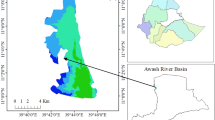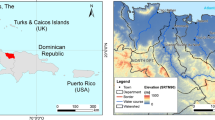Abstract
Process-based groundwater flow models are an important tool for gaining useful insights into the hydrogeological characteristics of a complex aquifer system. A conceptual model of a multilayer alluvial aquifer system at the base of Karewa mountain front is presented indicating the hydrogeological framework and the various flow processes affecting the groundwater flow system. Based on the conceptual model, a MODFLOW NWT-based numerical simulation model of groundwater flow was developed for the region. As interpreted from the hydrogeological framework, the simulation was carried out in the context of two aquifers, the top minor aquifer which is regarded as confined–unconfined and the lower major predominantly confined aquifer. Hydraulic heads measured in 104 wells during predevelopment period were used to calibrate hydraulic conductivity, natural recharge and evapotranspiration for the steady state model. For validation, observations from 38 wells corresponding to a recent steady state of aquifers were used. Performance statistic R2 = 0.83 and 0.79 for calibration and validation, respectively. Steady-state groundwater budgets including natural recharge were thus estimated. Calibrated horizontal hydraulic conductivity of aquifers is of the order of 0.0015–0.0031 m/s. Total natural recharge to the aquifers from precipitation and mountain subsurface flow corresponding to predevelopment and recent conditions was estimated as 96.39 and 64.21 Mm3/month, respectively. Steady-state simulations indicate an average decline of 2–5 m in groundwater heads over a period of about two decades, attributable to decreased recharge. Results of this model can help in sustainable development of groundwater in the region.








Similar content being viewed by others
Availability of data and material
The authors are responsible to provide the data pertaining to the research, on request.
Code availability
The software applications used in this study is available from Waterloo Hydrogeologic Inc., Canada and Environmental Systems Research Institute (ESRI), USA.
References
Ahlfeld DP, Barlow PM, Mulligan AE (2005) GWM--A ground-water management process for the US Geological Survey modular ground-water model (MODFLOW-2000). US Department of the Interior, US Geological Survey
Anderson MP, Woessner WW, Hunt RJ (2015) Applied groundwater modeling: simulation of flow and advective transport. Academic press, Amsterdam
Anonymous (2000) SSG software. The Scientific Software Group, Washington. http://www.scisoftware.com
Anonymous (2000) Waterloo Hydrogeologic Inc., Canada. www.waterloohydrogeologic.com
Azeref BG, Bushira KM (2020) Numerical groundwater flow modeling of the Kombolcha catchment northern Ethiopia. Model Earth Syst Environ 6(2):1233–1244. https://doi.org/10.1007/s40808-020-00753-6
Bhatt DK (1976) On the Quaternary geology of the Kashmir Valley with special reference to stratigraphy and sedimentation. Geol Surv India Misc Publ 24:188–204
Central Groundwater Board (2013) Ground water information booklet Badgam District, Jammu & Kashmir. Jammu. http://cgwb.gov.in. Accessed Mar 2019
Central Groundwater Board (2017) Report on aquifer mapping & management plan of Kashmir Valley, J&K (5200 sq.km.). http://cgwb.gov.in/AQM/NAQUIM_REPORT/JandK/Kashmir%20Valley.pdf. Accessed June 2020
Chandio AS, Lee TS, Mirjat MS (2012) The extent of waterlogging in the lower Indus Basin (Pakistan)–a modeling study of groundwater levels. J. Hydrol. 426:103–111. https://doi.org/10.1016/j.jhydrol.2012.01.017
Chiang WH (2005) 3D-groundwater modeling with PMWIN: a simulation system for modeling groundwater flow and transport processes. Springer, Berlin. https://doi.org/10.1007/3-540-27592-4
Coelho CD, Faria ACS, Marques EAG (2017) Comparative analysis of different boundary conditions and their influence on numerical hydrogeological modeling of Palmital watershed, southeast Brazil. J Hydrol Reg Stud 12:210–219
Dar RA, Romshoo SA, Chandra R, Ahmad I (2014) Tectono-geomorphic study of the Karewa basin of Kashmir valley. J Asian Earth Sci 92:143–156. https://doi.org/10.1016/j.jseaes.2014.06.018
deMarsily G (1986) Quantitative hydrogeology groundwater hydrology for engineers. Academic Press, Orlando, Florida, p 440
Diersch HJ (2009) FEFLOW finite element subsurface flow and transport simulation system, reference manual. WASY GmbH Institute for Water Resources Planning and System Research, Berlin
Domenico PA, Schwartz FW (1990) Physical and chemical hydrogeology. Wiley, New York, p 824
Flores-Márquez EL, Kohn Ledesma I, Arango-Galván C (2011) Sustainable geohydrological model of San Luis Potosí aquifer. Mexico Geofis Int 50(4):425–438
Gebere A, Kawo NS, Karuppannan S, Hordofa AT, Paron P (2020) Numerical modeling of groundwater flow system in the Modjo River catchment, Central Ethiopia. Model Earth Syst Environ 21:1–5
Harbaugh AW (2005) MODFLOW-2005, the US Geological Survey modular ground-water model: the ground-water flow process (pp. 6-A16). Reston, VA: US Department of the Interior, US Geological Survey. Doi: https://doi.org/10.3133/tm6A16
Jazayeri A, Werner AD (2019) Boundary condition nomenclature confusion in groundwater flow modelling. Tech Comment Groundw 57(5):664–668
Khadri SF, Pande C (2016) Ground water flow modeling for calibrating steady state using MODFLOW software: a case study of Mahesh River basin, India. Model Earth Syst Environ 2(1):39
Lydekker R (1878) Notes on the geology of Kashmir, Kishtwar and Pangi. Rec Geol Surv India 11(1):30–64
Maheswaran R, Khosa R, Gosain AK, Lahari S, Sinha SK, Chahar BR, Dhanya CT (2016) Regional scale groundwater modelling study for Ganga River basin. J Hydrol 541:727–741
Markstrom SL, Niswonger RG, Regan RS, Prudic DE, Barlow PM (2008) GSFLOW-Coupled Ground-water and Surface-water FLOW model based on the integration of the Precipitation-Runoff Modeling System (PRMS) and the Modular Ground-Water Flow Model (MODFLOW-2005). US Geol Surv Tech Methods 6:240
McDonald MG, Harbaugh AW (1988) A modular three-dimensional finite difference groundwater flow model. US Geol Surv Open File Rep 83–875:528
Niswonger RG, Panday S, Ibaraki M (2011) MODFLOW-NWT, a Newton formulation for MODFLOW-2005. US Geol Surv Tech Methods 6(A37):44
Palma HC, Bentley LR (2007) A regional-scale groundwater flow model for the Leon-Chinandega aquifer. Nicaragua Hydrogeol J 15(8):1457–1472
Panday, Sorab, Langevin CD, Niswonger RG, Ibaraki, Motomu, Hughes JD (2017) MODFLOW-USG version 1.4.00: An unstructured grid version of MODFLOW for simulating groundwater flow and tightly coupled processes using a control volume finite-difference formulation: U.S. Geological Survey Software Release 6(A45):66. Doi: https://doi.org/10.5066/F7R20ZFJ
Prasad YS, Rao YR (2018) Groundwater flow modelling of a micro-watershed in the upland area of East Godavari district, Andhra Pradesh, India. Model Earth Syst Environ 4(3):1007–1019
Shafiq MU, Islam ZU, Abida AW, Bhat MS, Ahmed P (2019) Recent trends in precipitation regime of Kashmir valley, India. Disaster Adv 12(4):1–11
Shafiq MU, Rasool R, Ahmed P, Dimri AP (2019) Temperature and precipitation trends in Kashmir Valley, north western Himalayas. Theor Appl Climatol 135(1–2):293–304. https://doi.org/10.1007/s00704-018-2377-9
Singh A (2014) Groundwater resources management through the applications of simulation modeling: a review. Sci Total Environ 499:414–423. https://doi.org/10.1016/j.scitotenv.2014.05.048
Zume T, J, Tarhule AA, (2011) Modelling the response of an alluvial aquifer to anthropogenic and recharge stresses in the United States Southern Great Plains. J Earth Syst Sci 120(4):557–572
World Bank (2010) Deep wells and prudence: towards pragmatic action for addressing groundwater overexploitation in India. Report, World Bank, Washington, DC
Zhou Y, Li W (2011) A review of regional groundwater flow modeling. Geosci Front 2(2):205–214. https://doi.org/10.1016/j.gsf.2011.03.003
Acknowledgements
The authors are thankful to the Central Groundwater Board, India; Directorate of Geology and Mining, Government of Jammu and Kashmir (erstwhile) and Irrigation and Flood Control Department, Government of Jammu and Kashmir (erstwhile) for providing the necessary data for the present study. The authors are also grateful to the anonymous reviewers whose reviews helped a great deal in improving the manuscript.
Funding
The authors did not receive support from any organization for the submitted work.
Author information
Authors and Affiliations
Corresponding author
Ethics declarations
Conflict of interest
The authors have no conflicts of interest to declare that are relevant to the content of this article.
Additional information
Publisher's Note
Springer Nature remains neutral with regard to jurisdictional claims in published maps and institutional affiliations.
Rights and permissions
About this article
Cite this article
Raazia, S., Dar, A.Q. A numerical model of groundwater flow in Karewa-Alluvium aquifers of NW Indian Himalayan Region. Model. Earth Syst. Environ. 8, 871–882 (2022). https://doi.org/10.1007/s40808-021-01126-3
Received:
Accepted:
Published:
Issue Date:
DOI: https://doi.org/10.1007/s40808-021-01126-3




